Storage location for notes that I write down after trips birding, herping, and other stuff! Young and relatively new birder, based in Austin, TX. All photos are mine.
Don't wanna be here? Send us removal request.
Photo










West Bouldin Creek and Hornsby Bend (Jan 11, 2018)
My first real, normal trip around Austin in 2017! This is discounting the Pace Bend/Commons Ford trip I made on the 3rd because that was a deliberate part of the Big Week. Today I started off (a bit late) at West Bouldin Creek, then made stops at the Peninsula Trail, Hornsby, and Lake Pflugerville.
West Bouldin Creek Greenbelt
My first time at this site! I came because there had been a number of fairly consistent-seeming recent reports of Winter Wrens (Troglodytes hiemalis), and I wanted to make sure I found one before the end of winter this year (I missed this species in 2017, probably mostly for lack of an effort to find one). I didn’t end up finding this bird, maybe because I didn’t actually get here until about 9:45, but it was still a pleasant morning and a good reconnaissance visit to a new site! I think this place is probably worth a repeat trip at some point.
It’s mostly the typical Travis County greenbelt habitat with mixed Live and Spanish Oak (Quercus fusiformis and Q. buckleyi) / Cedar Elm (Ulmus crassifolia) / Juniper (Juniperus ashei and J. virginiana) woodlands, with a good amount of fairly thick understory which seems reasonable for the wrens I came looking for.
While I didn’t find the wren, I did find new year birds in White-eyed Vireo (Vireo griseus) and several Hermit Thrushes (Catharus guttatus)!
Hornsby Bend
Just drove around the ponds today and literally never got out of the car - as well as just checking out the water birds I was also trying out a new camera for more or less the first time! Had a reasonable amount of success in general, although at this point I hadn’t yet figured out how to mess with any of the exposure-related parameters so a lot of my photos of ducks against bright water didn’t come out too well. Others (including those included here) I was mostly happy with, though!
The waters were a little quiet today, and so I actually made deliberate counts of all the birds, including the Northern Shovelers (Spatula clypeata) which I usually just estimate to the nearest twenty or so - today I had 174. I also saw several pretty interesting birds - the first was an Egyptian Goose (Alopochen aegyptiaca) right on the first dirt road to the north of P1E. This is an introduced species which I occasionally see feral at urban parks (Pace Bend comes to mind) around Austin, but which I’ve never seen at Hornsby before. The hackberries along the south end of P2 produced a Golden-crowned Kinglet (Regulus satrapa), which are really uncommon in Austin - but this is already my second in Travis County this year. I also had a Scissor-tailed Flycatcher (Tyrranus forficatus) on a little tree between the ponds when I was driving out! These birds are ubiquitous in Austin during the summer, but they almost all leave during the winter and this individual was flagged as an eBird rarity. We also had six STFL during our day on the Austin CBC a few weeks ago, though, so I wonder if these are more common in winter around here than I might have thought.
Lake Pflugerville
I came here in hopes of re-finding the American Bittern which was present here last January, although none had been reported yet this year. It was incredibly windy, though - upwards of 30mph - and I didn’t really see much of anything at all in the reeds, other than a single Marsh Wren (Cistothorus palustris). There were also a surprising number of water birds out on the lake despite the wind (and the multiple windsurfers) - mostly American Coots (Fulica americana) but also a number of grebes and ducks, including a dozen or so Canvasbacks (Aythya valisineria). Those aren’t common in most water bodies in Austin, but this lake is a pretty solid and consistent site for them.
Although I didn’t find a Bittern, I saw later on that one was reported by someone else at this location that very morning! And Arman also heard Virginia Rails (Rallus limicola) vocalizing (another repeat bird from last year) - so I imagine I’ll definitely have to be back, probably earlier in the day and with less wind.
#birds#birding#texas#austin#nature#plants#hornsby bend#lake pflugerville#central texas#ducks#wrens#rails#bitterns#flycatcher#kinglet#goose#vireo#thrush#oaks#elm#juniper
2 notes
·
View notes
Photo

Big Week Day 7 - Cleanup and Lake Sammamish (Jan. 07, 2018)
Today was about trying to clean up on missed birds for the week, especially stuff I wouldn’t get another shot at this year! There were several big PNW specialties that I was targeting, and I hit pretty much all of them! There were also two more birds which I had hoped might be possible which I missed - the Northern Shrike (Lanius borealis) and American Dipper (Cinclus mexicanus), both of which would have been lifers, and both of which are apparently sometimes seen in the area of Lake Sammamish. These were also both stretch goals, though, so I wasn’t too sad about them. :)
Seattle Area Cleanup
First thing in the morning I headed to the North Seattle Community College. There’s a little bit of woods and a couple tiny ponds on the grounds here, and while there isn’t too much habitat overall and it’s right in the middle of the city, it still seems for some reason to be one of the more reliable eBird hotspots for both Pacific Wrens (Troglodytes pacificus) and Varied Thrush (Ixoreus naevius). Both of these species are common in woodland habitat all over the PNW, but they tend to be secretive, and I just hadn’t spent enough time in woods yet this week to find either.
I found my thrush almost right away, perched up briefly in view on the top of a small tree with some robins right around dawn - I thought this was a little weird, but it’s not a bird that you can mistake. Do these two species ever associate? And is it common for the thrushes to perch up like this outside of the breeding season when they sing? I’m just not familiar enough with the species to say. Definitely a Varied Thrush though and not a juvenile Robin or anything weird like that.
The wren took a good bit longer to pick up, but I eventually found one in the thick underscrub under the woods at the north end of the campus. Actually, I found two, both of them calling. There’s also a couple little ponds which were had a surprising number of ducks, and some other good stuff about like a bunch of chickadees (both Black-capped and Chestnut-backed).
After this I made a reaaaally brief stop at Sakuma Viewpoint - a tiny little park on the edge of the water kind of near the UW campus. There had been a California Scrub-Jay (Aphelocoma californica) reported here for a while, and I managed to find it in a tree across the street! There were a decent number of birds in the four or so total plants and on the tiny stretch of water the park overlooked, too.
Lake Sammamish
A little park on the south end of the lake - it’s pretty developed, but there’s still a decent amount of naturalish habitat around the edges and along a couple of the trails. The big, certain-seeming target bird here was Cackling Goose (Branta hutchinsii) - and there were a bunch of these! The first one I saw was on a lawn near the parking lot amid a bunch of Canada Geese (Branta canadensis), which offered a really nice structural comparison. The difference - here at least - was fairly obvious. I say here because I think these species kind of cline into one another in some areas and my impression is it can sometimes be tricky. I wouldn’t know too much about that though because this was actually a lifer! Later on I saw big groups of both geese spooked up into the air by something (maybe an eagle?). At that point the flocks mostly kept separate from one another, and they were again really obviously different both in call and in structure - the difference in neck length was especially striking.
Some of the pines near the mouth of the little stream into the lake were pretty surprisingly productive, with chickadees and a first-of-year Red-breasted Nuthatch (Sitta canadensis). This was my last year bird of the week, and it brought me up to a total of 204! Whoop! Week goal broken!
I also found the area where I think people see Dippers here - a fairly fast-flowing little section of that same stream I mentioned before. I couldn’t find any dippers, or any Northern Shrikes either overlooking the fields beyond. Still a successful morning regardless though, and a good end to the week. :)
Overall, the Big Week went really well! There were a few surprising misses, like Tufted Titmouse (Baeolophus bicolor) and Harris’s Sparrow (Zonotrichia querula), but also a lot of good and unexpected stuff, and a total of five lifers! It also continued to reinforce my ideas about trying to make this whole year a little bit big... We’ll see about that, though. ^-^
4 notes
·
View notes
Photo


Big Week Day 6 - Skagit County (Jan. 06, 2018)
Made a trip this morning for more prairie-ish stuff and some cleanup of missed water birds, first to Samish Flats, then Samish Island, and finally a stop off in Skagit WMA. Did pretty well overall, although I missed a couple shots at Northern Shrike (Lanius borealis), which would have been a lifer. Still though, those are potentially get-able in N TX, so that’s not too big a loss! Just another excuse to take a weekend trip later this winter. ^-^
Samish Flats
Lots and lots of great stuff!! Most of the land around here looks like it’s private farmland, so it’s all birding from the road within the car.
A number of kinda insignificant year birds, just because I haven’t been in prairie habitat much yet, like Brown-headed Cowbird (Molothrus ater), Brewer’s Blackbird (Euphagus cyanocephalus), and Western Meadowlark (Sternella neglecta). There’s also an incredible number of Bald Eagles (Haliaeetus leucocephalus) - up here they’re like Turkey Vultures back home. This might not be a coincidence, since there aren’t any vultures this far north in the winter - I’d guess the eagles are filling in to eat most of the carrion in their absence.
Also lots of other really good stuff though, including a Rough-legged Hawk (Buteo lagopus), a Eurasian Wigeon (Macera penelope), a Short-eared Owl (Asio flammeus), a continuing Prairie Falcon (Falco mexicanus) which is apparently rare up here, and at least one lifer Tundra Swan (Cygnus columbianus) among the ubiquitous Trumpeters (Cygnus buccinator). Overall it was pretty good, and I’d imagine definitely worth a return visit!
Samish Island
Mostly residential with only a couple public access beaches and so far as I could tell not much in the way of publicly accessible forest land. That said, the couple beaches were pretty good for sea birds, and in particular are seemingly reliable for Long-tailed Ducks (Clangula hyemalis), which is the main reason I came up here - I saw four! I also got my first-of-year Common Goldeneyes (Bucephala clangula) and Eurasian Collared-Doves (Streptopelia decaocto).
Skagit WMA
Stopped by here for a last-ditch attempt at a Northern Shrike and picked up an accidental Black Phoebe (Sayornis nigricans) instead! It didn’t seem too active while I was here, maybe because there’s active hunting going on right now. However I ran into another birder who told me of another site she knew for the shrike, and lead me over there - down near the water at the end of Rawlins Road. I went out there with her but didn’t have enough time to stick around beyond a quick scan, which didn’t yield much. It did seem like great shrike habitat though, and probably American Bittern habitat, too (several people told me they’d seen bitterns here).
#birds#birding#washington#nature#ducks#goldeneye#wigeon#swan#shrike#phoebe#falcon#hawk#eagle#cowbird#blackbird#meadowlark
1 note
·
View note
Photo









Big Week Day 5 - Seattle (Jan. 05, 2018)
A day of Land Birds, mostly! Started out at the Union Bay Fill, then stopped by Green Lake before heading to lunch with my best friend! After that I drove up to Richmond Beach briefly and then finally down to Discovery Park.
Union Bay Natural Area
A pretty nice spot, with a really huge number of ducks far out in the bay! Probably worthwhile to come back with a scope next time, but today I was mostly searching for the Redpolls that had been reported here the day before. Didn’t find those, but did find a lot of other good year birds. Watery things included Hooded Mergansers (Lophodytes cucullatus), Greater Scaup (Aythya marila), and Trumpeter Swans (Cygnus buccinator). This was the first real land birding I did in WA this week too, turning up Anna’s Hummingbirds (Calypte anna), Black-capped Chickadees (Poecile atricapillus), Bushtits (Psaltriparus minimus), and Marsh Wrens (Cistothorus palustris).
Green Lake
A pretty brief trip to an extremely suburban park, but the Common Redpolls (Acanthis flammea) were really easy to find exactly where they’d been reported the previous day! This was probably the lifer on this trip that I was most excited about. :) There were also some ducks and gulls on the lake, including a bunch of Common Mergansers (Mergus merganser).
Richmond Beach Saltwater Marsh
Stopped by here really briefly to find Black Scoters (Melanitta americana). At first all I could find were Surf Scoters, but after searching for a while I found a whole group of M. americana way out on the water to the north! This was probably the best view I’ve yet had of this bird, although it was still pretty distant.
Discovery Park
Walked the main Loop Trail in search of more forest birds! It was lightly drizzling off and on, late afternoon, and overall really pretty quiet! I did find a few good things though, including Chestnut-backed Chickadees (Poecile rufescens), Pine Siskins (Spinus pinus), and a surprise Pileated Woodpecker (Dryocopus pileatus). This might be worth a return visit on a morning in the future, or down to the actual coastline, but a lot of the big, older forest plots I’ve visited in the PNW have seemed a bit similarly quiet in my experience. Maybe there’s a better time of year to visit too?
I also took a lot of photos of plants while here to iNat! I’m not really sure what pretty much any of these are yet though. :)
#birds#birding#seattle#washington#nature#ducks#scoter#merganser#chickadee#siskin#woodpecker#redpoll#wren#swan#bushtit#hummingbird
2 notes
·
View notes
Photo










Big Week Day 4 - Seattle / Point No Point (Jan 04, 2018)
First day in Seattle was really successful! I stuck pretty exclusively to the coast today, first at the Alki Beach area, then across the Bainbridge Ferry, and finally at the Point No Point Lighthouse.
Alki Beach
Really productive! Stopped at the Charles Richey Sr. Viewpoint and then followed the coast all the way around up to Luna Park. Charles Richey has some nice rocky/kelpy outcroppings just off the shore which were covered in Harlequin Ducks, and the water had a number of Scoters including one White-winged Scoter (Melanitta deglandi), which I’m glad I picked up so quickly and didn’t have to actively search for.
Alki Beach also had a good bit of rocky shoreline which produced a few Black Turnstones (Arenaria melanocephala) and Surfbirds (Aphriza virgata). The water all along here also held more Surf Scoters (Melanitta perspicillata), Horned and Eared Grebes (Podiceps auritus and P. grisegena), and several new-for-year Gulls (Larus spp.) and Pelagic Cormorants (Phalacrocorax pelagicus), and Red-breasted Mergansers (Mergus serrator).
Seattle-Bainbridge Ferry
This trip was mostly fairly quiet, with lots more cormorants and gulls. Did see a number of Western Grebes (Aechmophorus occidentalis), though, and had distant views of four species of Alcid! A Common Murre (Uria aalge), a Pigeon Guillemot (Cephus columba), an Ancient Murrelet (Synthliboramphus antiquus) and some Marbled Murrelets (Brachyramphus marmoratus).
Point No Point
Really nice! All three common species of Loon, including a lifer Red-throated Loon (Gavia stellata), a flock of Brants (Branta bernicla), and more alcids including a Rhinoceros Auklet (Cerorhinca monocerata). There’s also a section of marshy water and a slope up to some forest where I saw my first-of-year Canada Geese (Branta canadensis) and Golden-crowned Sparrows (Zonotrichia atricapilla). Another spot that’s definitely worth a return visit. :)
Overall a really successful day, and I was able to knock out pretty much all of the big year needs for ocean birds! Consequently, the plan was to focus the next day on land birds, and then the following two on cleanup.
#birds#birding#Seattle#Washington#nature#ducks#harlequin duck#merganser#scoter#goldeneye#gulls#geese#brant#alcids#grebes#sparrows#turnstone#surfbird
4 notes
·
View notes
Photo




Big Week Day 3 - Central Texas (Jan 03, 2018)
The third day of the year and week! Last night I got back to Austin and early tomorrow morning I fly to Seattle, so today I focused on trying to knock out as much Southwestern US and Central TX specialty stuff as I could while I was here! To that end I went to Pace Bend first thing in the morning, and then swung by both Commons Ford and the little Peninsula Trail in Lady Bird Lake, where some interesting rarities have been recorded lately.
Pace Bend
The big targets here were the few southwestern species which can be found here and which I wouldn’t be able to pick up this week in Seattle. Pace Bend’s bird habitat is mostly scrubby mesquite/grass savannah mixed with other shrubs, on rocky coastline over twenty foot dropoffs to the Colorado River. I’ve never had too much luck here in terms of watery birds (although this was notably the site of an extended visit by a Common Merganser all last winter) - sometimes a handful of ducks and usually a few herons and cormorants, but not too much activity. Maybe this is because of all the water traffic and waves from boats?
The scrubby land stuff itself can be fairly productive though, in particular for sparrows! Today I had dozens of all the expected normal sparrows, but also some pretty good less-common finds. I had a Black-throated Sparrow (Amphispiza bilineata) almost as soon as I got out of the car at the first campsite stop. Then I headed up to the higher elevation pure juniper woods at the hiking trails at the north end of the park, and found surprise Dark-eyed Juncos (Junco hyemalis) and a Golden-crowned Kinglet (Regulus satrapa)! I’m continually noticing that birds which I typically associate with rocky mountain pine forests also seem to show up most often here in Travis County in otherwise often sparsely populated thick juniper woodlands. I wonder whether these are birds from juniper woods higher up in the hills of New Mexico and Arizona, or if they’re from montane pine and if there’s just something about conifers that they like.
Coming back down from the juniper and back into the scrubby savannah campsites I kept searching for a while longer and managed to find a Rufous-crowned Sparrow (Aimophila ruficeps), a pair of Canyon Towhees (Melozone fusca), several Woodhouse’s Scrub-Jays (Aphelocoma woodhouseii), a flock of Lesser Goldfinches (Spinus psaltria), a Greater Roadrunner (Geococcyx californianus), and a Verdin (Auriparus flaviceps)! The last was actually a personal first for Travis county, and definitely not something I came here expecting. All in all, I really cleaned up on pretty much all the southwestern stuff I was looking for.
Pace Bend is definitely my favorite place in Travis for these kinds of birds - and the fact that it’s such great sparrow habitat in general definitely adds to its charm. I still haven’t ever actually been here in summer, though - I should try it at some point this year! I hope the wintering sparrows turn nicely into breeding Cardinalids.
Commons Ford
This trip was mostly to clean up on woodsy things that I’d hereto missed out on - I managed to snag both our Melanerpes woodpeckers, a Ladder-backed Woodpecker (Dryobates scalaris), (finally) Carolina Chickadees (Poecile carolinensis) and Black-crested Titmice (Baeolophus atricristatus), and Cedar Waxwings (Bombycilla cedrorum).
I also got another good look at the continuing female Eastern Towhee (Pipilo erythrophthalmus) which has been hanging out here the last few times I’ve visited! It usually forages with several of its Spotted Towhee congeners (Pipilo maculatus) - I wonder if we ever get any hybrids wintering in Texas. I hadn’t ever heard of this, but it looks like the two breeding ranges overlap very slightly more or less directly north of Austin in CO, NE, MO, and parts of south central Canada. This website also documents the occurrence of regular hybridization in CO! How confident can we be that silent, slightly out-of-range birds are pure individuals? And how much individual variation is there within each sex towards the appearance of the other species? These two were only very recently split from the old ‘Rufous-sided Towhee’, after all!
Peninsula Trail
The past couple weeks, a number of very interesting birds had been recorded here - a Townsend’s Warlber (Setophaga townsendi), a Cape May Warbler (S. tigrina), and a Chestnut-sided Warbler (S. pensylvanica)! None of these birds should winter in Austin, and the first two are very rare here even as migrants (I’ve never seen either in Travis County).
I wasn’t expecting too much, because I was getting here pretty late in the day, and because they hadn’t been reported in the last several days - and I didn’t actually see any of these birds. I did see a Ringed Kingfisher (Megaceryle torquata), which are uncommon but regular along the Colorado River in this area. I also saw feral Monk Parakeets (Myiopsitta monachus), and I nearly jumped out of my skin when I flushed an American Woodcock (Scolopax minor) right off the edge of the trail! I didn’t see a single Woodcock in all of 2017, so I was pretty happy to pick one up so early in 2018. One fewer bird to worry about for listing purposes, especially since there’s not really anywhere I’m aware of in Central Texas where this species is really reliable.
I ended the day at 146 species - a big jump up from the previous day, with 33 more birds! As of the morning of Jan 04, eBird states that I’ve reported more birds in Texas than any other person in 2018. It won’t last when I vanish out-of-state for the next six days, but it’s an exciting screenshot to lock away for posterity. My goal of breaking 200 species in the first week of 2018 is still alive. :)
#texas#birds#birding#nature#austin#sparrows#roadrunner#woodcock#parakeet#kingfisher#woodpeckers#titmouse#chickadee#waxwing#warblers#jays#finches#kinglets#verdin#central texas#edward's plateau#pace bend#commons ford
2 notes
·
View notes
Photo

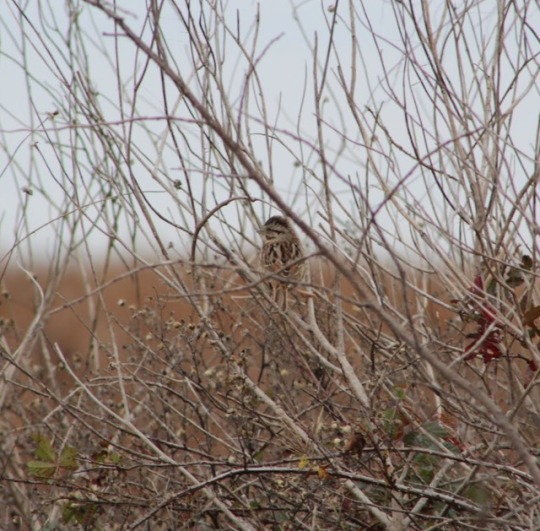








Big Week Day 2 - Attwater Prairie Chicken Refuge (Jan. 02, 2017)
The second day of the little Big Week! I didn’t actually spend all that much time birding today, and almost all of it was in the car on the way back to Austin from my parent’s house in Houston. Still, I had a pretty good time and picked up a few new species for the year!
Got most of the expected prairie stuffs! In terms of sparrows, I got Vesper (Pooecetes gramineus) and Savannah (Passerculus sandwichensis), Grasshopper and Leconte’s (Ammodramus savannarum and A. leconteii), Song and Lincoln’s Sparrows (Melospiza melodia and M. lincolnii). There were tons of Northern Harriers (Circus cyaneus) and a single Short-eared Owl (Asio flammeus). The individual Brown Thrasher near the bird blind which might have been my lifer of this species two years ago put in an appearance too, as well as first-of-year Sandhill Cranes (Gruus canadensis) and American Crows (Corvus brachyrhynchos)!
I had a covey of nine Northern Bobwhites (Colinus virginianus) flush off the side of the path in a very short and sparse area of grass to the northwest end of the auto loop, a bit before the observation platform. Also thousands of Snow Geese (Chen caerulescens) and a single flock of Greater White-fronted Geese (Anser albifrons) too, which might have been my first geese at this site - although of course not for the year, since I was in Anahuac yesterday. Still no Chickadees or Titmice though, which officially means I’ve missed Tufted Titmouse (Baeolophus bicolor) for the week (since I’m going to be in BCTI territory tomorrow). I also still haven’t ever actually seen a Greater Prairie Chicken (Tympanuchus cupido), although I’m really continually unsurprised by that.
#birds#birding#texas#houston#nature#sparrows#harrier#owl#thrasher#crane#crow#quail#geese#titmice#chickadees#prairie chicken#prairie#upper texas coast
3 notes
·
View notes
Photo





Big Week Day 1 - Anahuac / Smith Oaks / Bolivar Flats (Jan 01, 2018)
A little Big Day to kick off the year! My dad and I went down to Galveston and did a tour of the Bolivar side in an attempt to get as many species as we could, and also to kick off both a big week for me and the 2018 year for both of us. We did Anahuac, Smith Oaks, Tuna Rd and Rollover Pass (both of which were pretty uneventful), and Bolivar Flats! Then we went across the ferry and made a short stop to try to find the recently reported Black-throated Gray Warbler (Setophaga nigrescens) in Galveston. We got there pretty late and missed this one, and didn’t make it to the planned stop at Texas City Dike or the Houston Yacht Club (the latter for the Black-legged Kittiwake, Rissa tridactyla), but still had a really good day despite.
This was in the middle of one of the most severe cold snaps we’ve had here in a long time, and it didn’t get much above freezing all day. Some of the land birds might have been a little less active because of this, but overall things still seemed to be moving around pretty well! It did make it a bit chilly standing out alone in the wind on Bolivar, but other than that it didn’t have too big of an impact (I just wore about a million layers on every inch of my body).
Anahuac National Wildlife Refuge
Walked the Willow Trail area for about 45 minutes, then drove all the way around Shoveler Pond. Every bird here was a new one for the day, week, and year counts, so it was pretty exciting! We picked up most of the expected stuff, doing especially well on ducks. The best birds were White-tailed Hawk (Geranoaetus albicaudatus), Caspian Tern (Hydroprogne caspia), Vermilion Flycatcher (Pyrocephalus rubinus), Sedge Wren (Cistothorus platensis), and Swamp Sparrow (Melospiza georgiana).
Smith Oaks Woods
Pretty nice! Did a walk through the woods and past the Rookery. Overall pretty birdy and picked up most of the things we needed, with the striking exception of chickadees and titmice! Good finds that I wasn’t sure if we’d get included Blue-headed Vireo (Vireo solitarius), Gray Catbird (Dumetella carolinensis), Brown Thrasher (Toxostoma rufum), Pine Warbler (Setophaga pinus), Wilson’s Warbler (Cardellina pusilla), and Fox Sparrow (Passerella iliaca). However, by far the best bird was a Harris’s Hawk (Parabuteo unicinctus) roosting in the middle of the rookery, surrounded by cormorants - absolutely not something we expected to find! Looking back now it seems to have been hanging out in the area possibly for some time.
Bolivar Flats
The flats along Retillon Road were really quiet, and we didn’t see the resident owl. I was worried the beach would be slow as well, but once we got out a bit further we found clusters of most of the usual suspects, including American Avocets (Recurvirosta americana), Ruddy Turnstones (Arenaria interpres), Sanderlings (Calidris alba), Dunlins (Calidris alpina), Least and Western Sandpipers (Calidris minutilla and C. mauri), and Black-bellied, Wilson’s, Semipalmated, Snowy, and Piping Plovers (Pulvialis squatarola, Charadrius wilsonia, C. semipalmatus, C. nivosus, and C. melodus). I was especially happy to get Wilson’s Plover on Jan 1, because I actually missed that bird all year in 2017!
The last finds of the day were Bonaparte’s Gulls (Chroicocephalus philadelphia) and a flyover Peregrine Falcon (Falco peregrinus) off of the ferry.
Concluding Thoughts / Misses
The biggest misses of the day were Bufflehead (Bucephala albeola), Redhead (Aythya americana), Willet (Tringa semipalmata), Tufted Titmouse (Baeolophus bicolor), Carolina Chickadee (Poecile carolinensis), and Cedar Waxwing (Bombycilla cedrorum). I also managed to miss seeing a House Sparrow all day, and somehow didn’t see a Feral Pigeon until getting on the ferry! I ended up at a flat 100 species, which was exactly my goal for the day. Overall a fantastic start to the new year! :)
If I do this again next year, I think the big lessons were: take less time at Anahuac and probably also at Smith Oaks; consider skipping Tuna/Yacht Basin/Rollover Pass but substituting in the Jetty down at the S end of the island; and try to make it to the dike! That spot has a lot of good deepwater stuff we missed out on like Eared and sometimes Horned Grebes (Podiceps spp.), Common Loons (Gavia immer), and Common Goldeneyes (Bucephala clangula), as well as interesting gulls every now and then.
#birds#birding#texas#galveston#nature#bolivar#anahuac#smith oaks#texas city dike#ducks#loons#grebes#gulls#falcon#plovers#turnstone#shorebirds#sparrows#thrasher#catbird#vireo#hawk#flycatcher#wren#marsh#sea#woods
2 notes
·
View notes
Photo
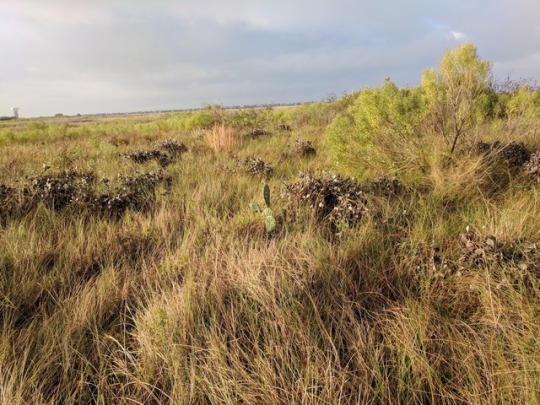
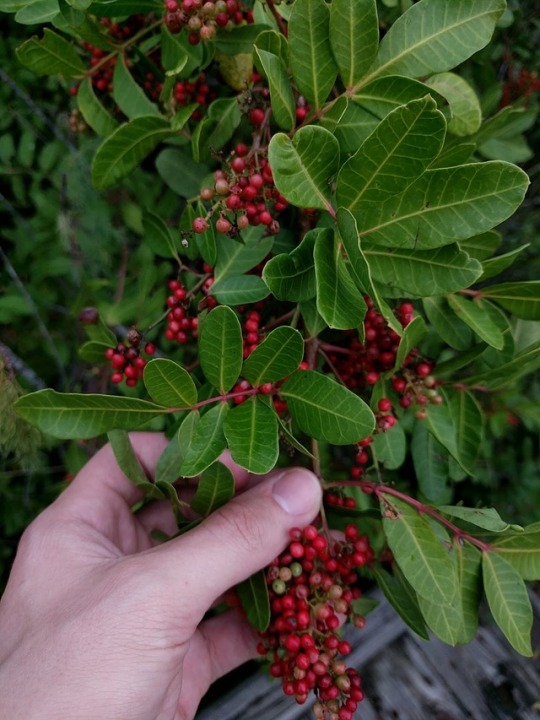
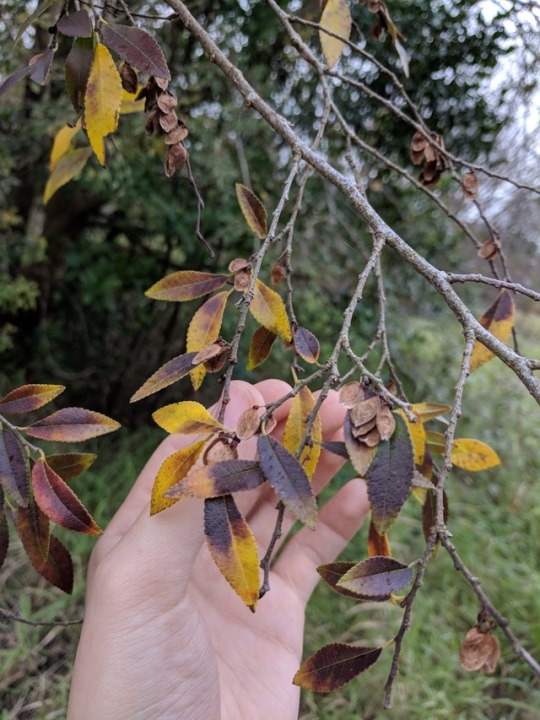
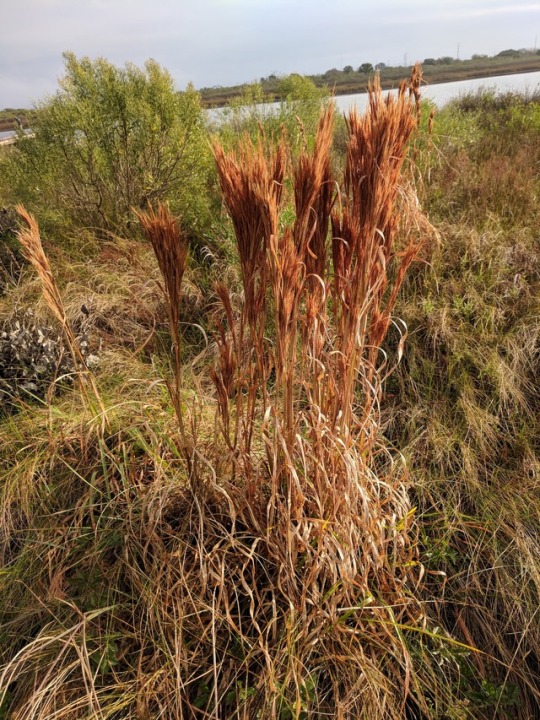
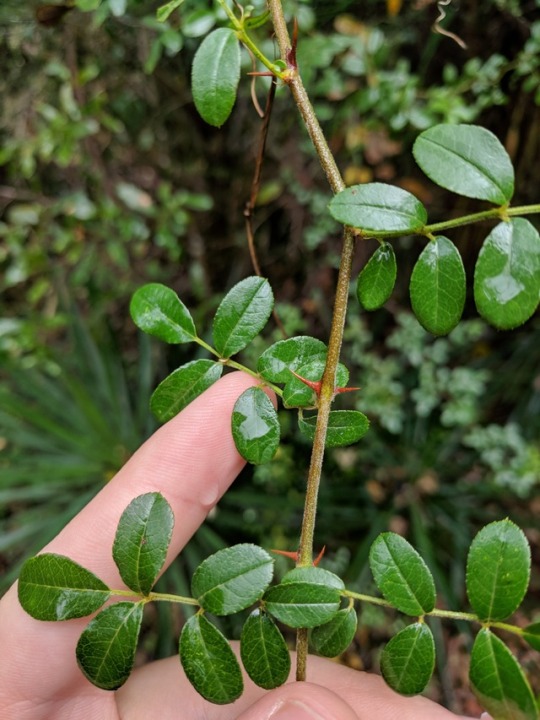
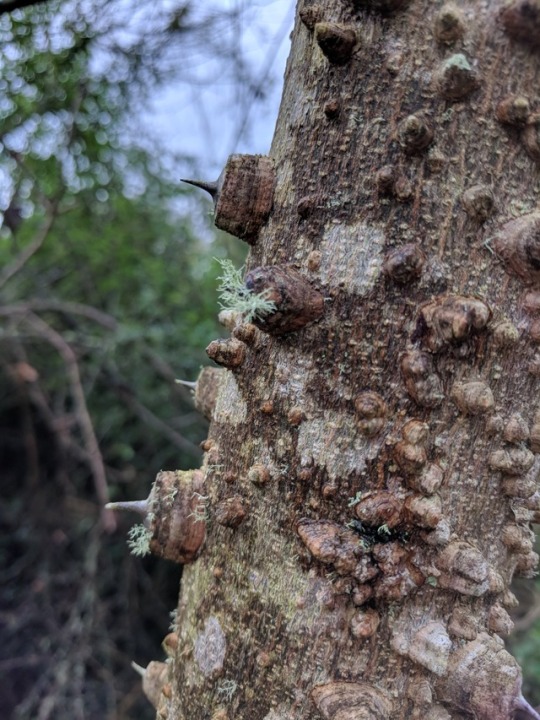
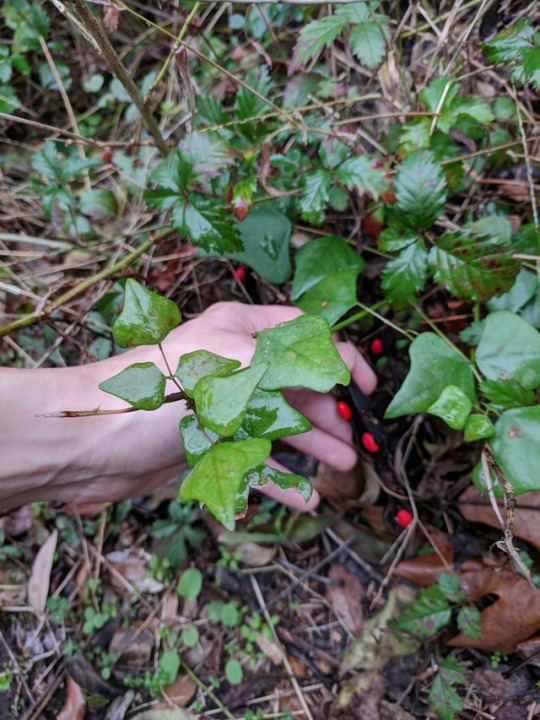
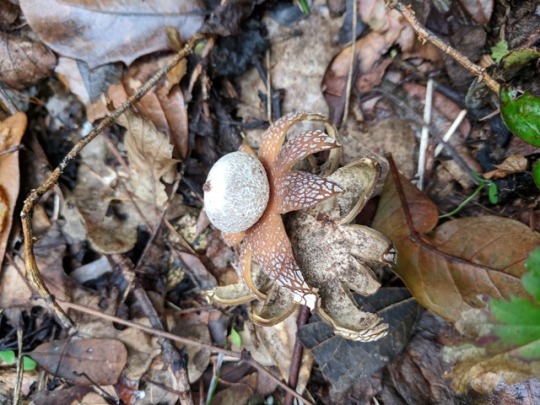

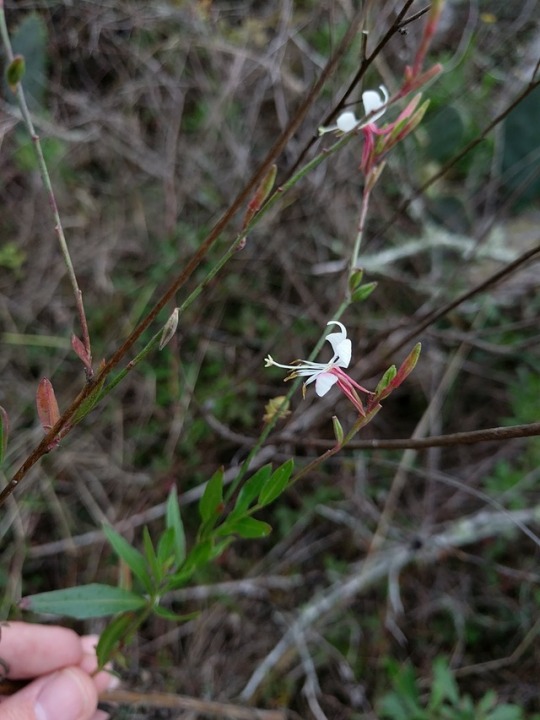
Galveston (December 30, 2017)
Went down to Galveston Island today with my friend Jenny! We did a big tour of a bunch of different places, stopping only fairly briefly at each site - including a couple places I hadn’t been before!
Galveston Island State Park:
A big open coastal grassy marsh! Lots of Western Ragweed (Ambrosia psilostachya), really pretty orange Bushy Bluestem (Andropogon glomeratus), and other grasses interspersed with shrubby Brooms (Baccharis sp.) and Cherokee Bean (Erythrina herbacea). This area was astoundingly full of White-tailed Kites (Elanus leucurus), Loggerhead Shrikes (Lanius ludovicianus) and Yellow-rumped Warblers (Setophaga coronata) - that last in particular I was a bit surprised by given the lack of any real trees. Also lots of wading birds of all kinds!
Lafitte’s Cove:
Interesting being here outside of migration. The ducks were pretty nice, and the woods were pleasant but nothing too crazy in terms of small birds. We did get a Swamp Sparrow (Melospiza georgiana) which I’m never thinking about or expecting but which I always love! Lots more Cherokee Bean in here as well as Southern Live Oak (Quercus virginiana) and other woody trees - and a pretty large amount of the invasive Macartney’s Rose (Rosa bracteata). We also found some Earthstars (Geastrales), a
8 Mile Road/Beach:
A really nice stop! We had a Clapper Rail (Rallus crepitans) dart across the road into grassy cover on the drive in, and both a Common Goldeneye (Bucephala clangula) and two Common Loons (Gavia immer) in the open water off the fishing stop at the end of the road! All three species are really great birds that I wouldn’t have planned to rely on, and the last one in particular is of my favorite birds overall. :)
Army Corp Woods:
A little quiet in terms of bird life, but very pretty in terms of plants! Dense shrubs of Carolina Laurelcherry (Prunus caroliniana), Southern Live Oak, and Brazilian Pepper-Tree (Schinus terebinthifolius) - the last another invasive. There were also a few Elms (Ulmus sp.) around, including at least one that I think I don’t know, as well as a Gaura (Gaura sp.) and a few other cute herbaceous flowering things!
Apfel Park:
Just a brief stop off here to pick off a few new shore and seabirds - Sanderlings (Calidris alba), Ruddy Turnstones (Arenaria interpres), a Caspian Tern (Hydroprogne caspia), and lots of other nice stuff! Someone had reported both a Parasitic Jaeger and a Little Gull here the day before, but they were seen far out over the water following ships, and it was foggy/rainy while we were here so we didn’t even really try for these very hard. It started pouring right before we left to see us off!
#Galveston#texas#birds#birding#plants#cherokee bean#oaks#pepper-tree#laurelcherry#bluestem#broom#rose#loon#tern#turnstone#sparrows#Melospiza#shrikes#warblers#kites
2 notes
·
View notes
Photo









East Texas Pine Woods (Late December 2017)
Back home with the family this week! The last month or so I’ve been almost exclusively birding (not looking at plants or insects in the winter cold), and that’s been really productive! Pine Warblers (Setophaga pinus), Brown-headed Nuthatches (Sitta pusilla) Pileated Woodpeckers (Hylatomus pileatus), and other nice E TX goodness galore.
Today though I actually took a decent number of plant photos again for the first time in a while! I don’t know the flora in these parts nearly as well as in Austin, but I’m hoping some of my iNat posts will help rectify that. The woods here seem to be mostly Loblolly Pine (Pinus taeda), Water Oak (Quercus nigra), Post Oak (Quercus stellata), Sweetgum (Liquidambar styraciflua), and American Holly (Ilex opaca), with a super dense understory of Yaupon (Ilex vomitoria). Most of the places I regularly visit are probably much more fire-suppressed than is natural - I wonder if the original habitat here had more grass and less Yaupon. Around here, between the Yaupon and dense ground cover of pine needles, there’s almost no grass cover at all.
I also found the entire semi-mummified body of a dead Virginia Opossum (Didelphis virginiana)! These guys continue to have entirely too many teeth.
I was surprised and happy to see a winter White-eyed Vireo (Vireo griseus). Also got to see a few cute Hermit Thrushes (Catharus guttatus) eating Yaupon berries, and learned that Carolina Chickadees (Poecile carolinensis) apparently continue to use roosting cavities even outside of the breeding season, when I saw one tuck itself down inside a hollow branch.
#birds#plants#texas#nature#birding#pine#oak#holly#east texas#nuthatch#woodpecker#vireo#thrush#chickadee#warbler#opossum#vulture culture
8 notes
·
View notes
Photo



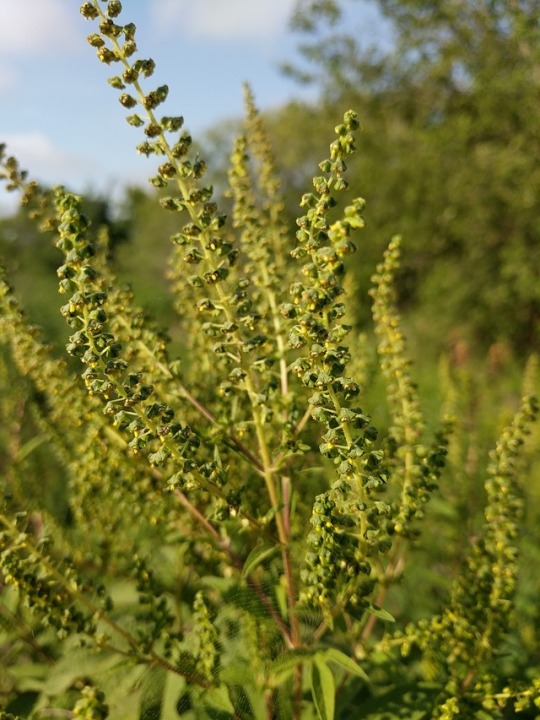
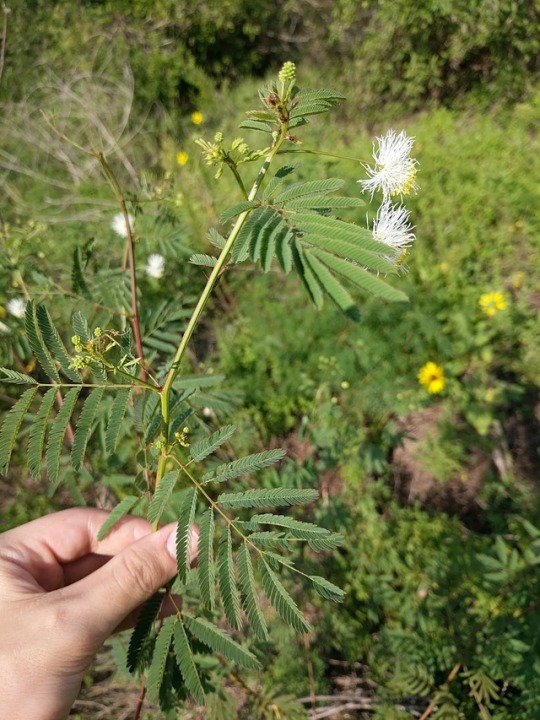
Mitchell Lake Audubon Center (Sep. 02, 2017)
Took a drive down here because there had been some rare phalaropes reported lately! Both a Red-necked and a Red Phalarope, although one SATX native I ran into told me he thought they were actually both RNPH. Either way though, they hadn’t been seen the day before, after half a week of reliability, and the only phalaropes present when I was here were Wilson’s.
It was still really nice, though! Apparently this was the best the lake has been in a long time for shorebirds - there were thousands bunched up with a bunch of egrets and ducks in the NW corner of the lake, on the edge of the Audubon center trails.
5 notes
·
View notes
Photo










Balcones District Park (Sep. 1, 2017)
Took a quick walk around the little park behind my apartment! It was kinda nice, but a little small and a kinda slow for birds. Kind of all the typical NW Austin habitat, with lots of juniper up away from the creek and more variety of stuff down closer to the water.
0 notes
Photo







Hurricane Harvey (Aug. 27-28, 2017)
Some photos from the aftermath of the hurricane recently, here in the Austin area. The bottom four pictures are from Saturday at Hornsby - all the ponds and drying beds were way higher than normal, and the shorebirds were all hunkered down in the grass around the edges. The top three are from the Mansfield Dam on Monday, where the Sabine’s gull had been hanging out!
1 note
·
View note
Photo










Tejas Camp (July 22, 2017)
A fairly short and quiet morning birding trip today! Birdy things are usually a little slow around here in July, and today definitely wasn’t any exception to that. It was nice to get back up here for the first time since April, though - and also for the first time since I really started trying to pay attention to plants!
The canopy here along the river is almost entirely elm, in contrast to our Live Oak / Hackberry woods further south, while the hilly stuff further off from the water is mostly Ashe Juniper, which is more in line with things back home. The riverside area has a pretty decent smattering of Chinaberry as well, and a little bit of Hackberry and Pecan (but not too much).
I’m still not familiar with most of the grasses I saw today, which is something I need to work on. There wasn’t too much Johnson Grass though, which was nice! Not tooo many notable insects, but at least a couple dragonflies and damselflies I haven’t seen yet that I need to figure out. :)
The most interesting bird of the day was a Swainson’s Hawk, which I don’t thiiiink is an expected breeding bird here (although it’s maybe on the edge of the range?). I’m not sure if this is just a wandering post-breeding bird, or if this is a more regular thing to see here, or what.
0 notes
Photo



Mitchel Lake Audubon Center (June 25, 2017)
Oops - still not being good about actually maintaining these up to date… Third time’s the charm! ^-^ Brief, lovely, first trip to Mitchell Lake Audubon Center today! All together it reminds me a lot of Hornsby back home. It’s a former water-treatment plant, now turned sanctuary. There’s a huge rookery here - all three white egrets and Neotropic Cormorants in huge numbers! Apparently there’s also a million pelicans but we didn’t make it to where they were. I finally had my lifer Groove-billed Ani here!!! And in a location that I never would have thought to hope for them! There’s apparently two pairs here. A friendly birder who knows the area better than we put us on them, and told us that these might be the furthest-north breeding pairs known. We also had Yellow-billed Cuckoos and Greater Roadrunners, so a good day overall for cuckoos! ;D
1 note
·
View note
Photo










Commons Ford / Mills Pond (May 21, 2017)
My first real plant walk! I mostly spent today looking at things underfoot while birding primarily by ear. Significant new-to-me but otherwise common plants included American Germander, Engelman’s Daisy, Standing Cypress, Common Mullein, Spotted Horse Mint, American Basketflower, Lemon Beebalm, and Inland Sea Oats (maybe my new favorite grass!). It feels like the entire prairie is flowering right now!
Interesting animals included begging, fledgling Parulas, a male Baltimore Oriole, and an Aztec Spur-throat grasshopper nymph. I also saw a female Painted Bunting actually fly in and land on a nest at the base of a lonely shrub in the prairie – I never would have seen the nest without her flying in right in front of me, but because she did I got a good view (from a respectful binocular-distance) of her peeking out at me from it, with just her tail and the tip of her head visible! I wonder how many birds I pass by every day on the nest without ever knowing they’re there. I also wonder how long the breeding timeline lasts for those guys around here - is she still on her first clutch? I saw my first fledgling cardinals at least a month ago!
I haven’t seen any Scissor-tailed Flycatchers here in a bit - it feels like at this site, they decreased around the time that our Western Kingbirds show up (weeks later) - do these get displaced from this site by their congenerics? Alternatively, maybe I’m just not paying enough attention to the sky lately. :P We’re now officially into the part of the summer that I don’t have a past reference to compare against, since I left on this date for California last year!
Afterwards, I stopped for a couple hours at Mills Pond and had a surprisingly good late afternoon there, with seven warbler species, all migrants. The highlight was a Mourning Warbler in at the blind - I’ve still only ever seen a few of these! I also found some weird, extremely unhealthy-looking poison ivy along the trail covered with a nasty bunch of yellow growths - not sure what’s up there!
#birds#birding#plants#texas#austin#spring#flowers#i'm running super behind on these logs even though i've already decided to skip over months of stuff just because i didn't feel like#i could catch up#oops#i'm going to try to be better about maintaining these#>:3
2 notes
·
View notes
Photo










Hornsby Bend (May 19, 2017)
Today was decent for birds, but honestly I spent most of the morning taking photos of plants and insects.
I got pretty good photos of a few dragonflies (Eastern Pondhawk, Roseate Skimmer, Swift Setwing, and a boatload of Thornbush Dashers). Before this trip I knew almost nothing about dragonflies, but I’ve started putting a teeny bit of effort into learning about them since – at least on the family level, and learning a few of our more common species. I was surprised how easy some of these were to digiscope, but others absolutely refused to ever hold still. I see a lot of iNat photos of people actually holding dragonflies though (either by the wings or perched on a finger) and I have absolutely no idea how they manage that.
Lots of Lepidoptera too! Three or four Common Buckeyes, every one with fairly substantial wing damage (the one pictured here was the healthiest-looking), a Funereal Duskywing, and a bunch of as-yet unidentified Skippers. I also found an Io Moth caterpillar, which I didn’t know anything about at the time, but which after later reading I’m glad I didn’t try to pick up! :) Skippers in particular seem a bit arcane to me; I’m not really sure where to begin on IDing the several I got photos of, and nothing has been forthcoming on my iNat observations.
Other interesting animals included two Spinybacked Orbweavers, a big dark wasp that I have no idea how to begin thinking about an ID for, and a velvet ant in the mesquite cutoff. I don’t think I’m really going to start addressing the challenge of learning our Hymenoptera for a little bit yet…
The birding scene was a little quiet, but the usual migrant mesquite spot at Platt was decent with several Redstarts and a Black-throated Green, and I saw a nesting Black-necked Stilt out on the mudflats south of P1W! The latter is neat because we’re outside of most of the breeding zone range maps for that species, although someone on iNat told me we usually have a few pairs stay to breed here. There were really no shorebirds at all anywhere in the facility except that one spot. There were also many fewer individuals of most species than I’ve seen in the past several weeks, and notably there weren’t any Least Sandpipers at all for the first time since last summer, so it definitely does feel like migration is starting to slow down.
Lots of new plants! Castor Oil Plant, which I see all the time on the edge of the ponds but have never known a name for; Poppymallow, which I also see scattered around, usually one-off flowers alone in open areas and edges; Johnson Grass, Taro, Virginia Wildrye, Buffalo Gourd, and Sorrelvine! I really want to start putting a bit more effort in becoming a bit more botanically literate, because I still know shockingly little about plants, outside of just being able to identify a few dozen of our more common species.
#birds#birding#insects#dragonflies#butterflies#lepidoptera#odonata#plants#hornsby#austin#spring#or honestly at this point maybe#summer
4 notes
·
View notes